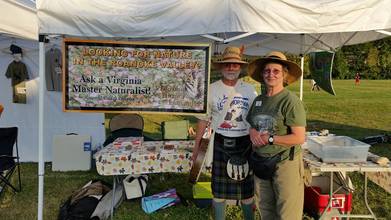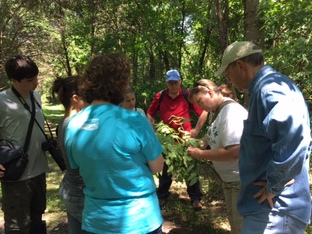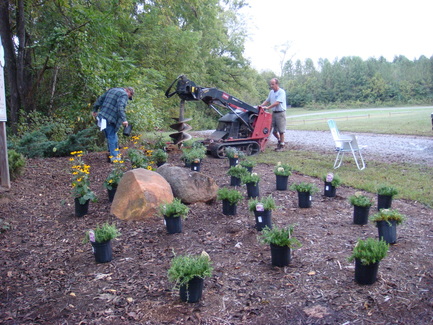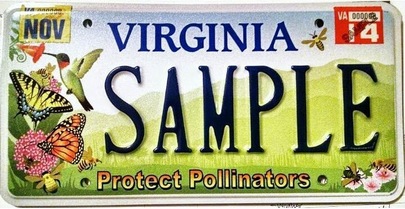 Art and Elizabeth Bailie (VMN-Roanoke Valley Chapter) man the chapter’s booth at Roanoke’s Go Outside Festival, teaching visitors about aquatic invertebrates.
Art and Elizabeth Bailie (VMN-Roanoke Valley Chapter) man the chapter’s booth at Roanoke’s Go Outside Festival, teaching visitors about aquatic invertebrates.
The VMN-Roanoke Chapter participated in the local Go Outside Festival Oct 14-16. The Go Outside Festival, presented by Anthem Blue Cross and Blue Shield, is an annual event to encourage healthy, active outside recreation. By combining the things outdoor enthusiasts love – camping, music, gear, races, and demos, and a beautiful outdoor setting – GO Fest is a celebration of everything outdoors. With more than 16 Chapter members covering shifts throughout the weekend, we shared our passion for the natural world and our knowledge with hundreds of folks. We demonstrated our education and outreach functions, as well as our citizen science contributions with live macro invertebrate lessons, and signed people up for not only our own classes, but stream monitoring as well.
 Photo of VMN-Merrimac Farm basic training course by Kathy Madsen.
Photo of VMN-Merrimac Farm basic training course by Kathy Madsen.
VMN Merrimac Farm Chapter just concluded our 2016 session of 11 enthusiastic candidates. At the VMN statewide conference, one of our newest graduates, Tucker Caldwell, photographer extraordinaire, won 3rd place in the Virginia Flora and Fauna contest.
The VMN Peninsula Chapter has several laurels to share this quarter. Volunteers Brad Halcums and Pam Courtney were honored for their volunteer hours and contributions to the Virginia Living Museum, a significant local partner for the chapter.
Chapter president Daina Henry was recognized as an outstanding volunteer at the James River Association’s River Raft Up.
In August, the Peninsula Chapter conducted a BioBlitz of Lucas Creek in Newport News. Ten VMN volunteers catalogued flora and fauna, collected water samples, and tested salinity. This resulted in a comprehensive map of the creek, and possible pollution areas to be further investigated. The event is now being considered by other James River Association monitoring groups for their local creeks.
 Paw Path Pollinator Garden planting. Photo by Kathy Fell
Paw Path Pollinator Garden planting. Photo by Kathy Fell
On Oct 1st, about 20 people from the Martinsville Garden Club, Garden Study Club, Master Gardeners and Master Naturalists spent the morning at the Smith River Sports complex, planting the Paw Path Pollinator Gardens. C.D. Prillaman, a local landscaper, volunteered to bring a power auger, which made quick work of the over 300 holes required. Native wildflowers, native trees and native shrubs were planted in the four new beds, flanking the entrance and exit to the Paw Path and in the woods along the dog walking trail. Gateway Streetscape, from Martinsville, volunteered to water the plants and arrived in a large water truck. The Dan River Basin Association (DRBA) installed a new split rail fence at the entrance, The DGIF Habitat Partners sign was installed at the entrance. Members from the two garden clubs are developing a long term maintenance procedure and will identify local organizations to keep the gardens looking nice.
The concept for the Paw Path Pollinator Gardens started back in January of 2016, with Judy Ware, Conservation Chair for the Martinsville Garden Club. Judy recruited Kathy Fell, from the Southwestern Piedmont Chapter of the Virginia Master Naturalists, to lead the garden design team. Several members from Martinsville Garden Club and Garden Study Club met with Kathy to learn how to design a pollinator garden. The team decided on about 50 different species of native wildflowers, native trees and native shrubs, of various heights, to provide a garden with continuous bloom from spring through fall.
On April 30th, over 40 volunteers from the Martinsville Garden Club, Garden Study Club, Master Naturalists, Master Gardeners, and two local Girl Scout troops spent the morning preparing the beds. Kathy provided a demonstration on how to use newspapers and mulch to kill the existing grass and recycle the nutrients into the soil. Two mountains of mulch and a truck load of recycled newspapers were quickly laid in place. The team did an excellent job. There were almost no weeds in the beds when we returned in October to plant the gardens.
We are working with a local Eagle Scout candidate and his troop to build some interpretive signs for the gardens. Students from Magna Vista High School built a number of “insect hotels”, designed to attract native pollinators.
 Photo from http://www.pollinatorplates.com/p/home.html
Photo from http://www.pollinatorplates.com/p/home.html
Shared from the VMN Arlington Regional Chapter’s blog, posted on September 9, 2016
The efforts of VMN Arlington Regional Chapter’s own Samantha Gallagher just keep generating wonderful benefits for pollinators. Samantha has always loved bees and other pollinators, advocating for them from a young age. When she moved to Virginia a few years ago, she learned that the state had a specialty license plate for wildflowers, but not for pollinators. So she decided to do something about it. Using her skills as a graphic artist, Samantha designed a custom plate that features Virginia native pollinators, and in 2010, began the long process to gain approval for a Protect Pollinators license plate.
Once she submitted the proposal to the Virginia Department of Motor Vehicles, the hardest part of the process began: getting 450 people to commit to purchasing the license plate and pay the specialty-plate fee in advance. The effort took four long years, with Samantha attending Earth Day activities, nature festivals, and any event even vaguely connected with pollinators. During that time she also kept in touch with those who pledged to buy the plate with her upbeat reassurances that it would become a reality.
After Samantha gathered the required applications, she still needed a state legislator to sponsor a bill to approve the pollinator plate. She found a perfect ally in someone who had already introduced pro-pollinator legislation: Virginia Senator Creigh Deeds. In January 2014, Deeds introduced the bill “to authorize the issuance of special license plates for supporters of pollinator conservation bearing the legend: PROTECT POLLINATORS.” On April 6, 2014, the bill became law.
While this was a wonderful accomplishment, it isn’t the end of the story.
In the summer of 2014, Nicole Hamilton of Loudoun Wildlife Conservancy had a brilliant idea. She had watched with despair as medians filled with milkweed and other wildflowers were mowed time and time again. She wondered: Can we simply change the mowing schedule to allow this valuable resource to continue growing for migrating Monarchs? And, ideally, use medians along Virginia’s highways to plant more milkweed and other native flowering pollinator plants as well? She contacted the Virginia Department of Transportation (VDOT) regarding changes to the mowing schedule for existing patches of milkweed and scheduled a meeting with VDOT’s vegetation management. She invited Samantha to attend the initial meeting as well; while Nicole could speak about the Monarchs, Samantha could speak about our native bees.
VDOT was excited about the opportunity, but there was an issue of funding for digging up existing fescue in medians and creating new plantings. The pollinator license plates were discussed as a potential fundraiser for what would eventually become VDOT’s Pollinator Habitat Program. This program provides for naturalized areas planted with native pollinator species along state-maintained roadways and also creates meadows and gardens with informative signage at park-and-rides and rest areas. [http://www.virginiadot.org/programs/pollinator_habitat_program.asp]
To make changes to the existing legislation, Samantha contacted local Senator George Barker, who agreed to sponsor an amendment to ensure that the revenue from the pollinator plate would be used strictly for the Pollinator Habitat Program. In July 2016, with more than 5,000 plates now on the road, the pollinator plates officially began generating revenue for the new program.
To learn how to get your own Protect Pollinators license plate and find out more about why this effort is so important, visit Samantha’s pollinator plate website at: http://www.pollinatorplates.com/. To read the full story of Samantha’s efforts to make the pollinator plate a reality, see Tom Sherman’s article, “The Bees, Creigh Deeds, and the DMV,” in The Zebra: http://thezebra.org/the-bees-creigh-deeds-and-the-dmv/.
